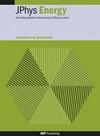Integrating direct air capture with small modular nuclear reactors: understanding performance, cost, and potential
IF 6.3
3区 材料科学
Q1 ENERGY & FUELS
引用次数: 0
Abstract
Direct air capture (DAC) is a key component in the transition to net-zero society. However, its giga-tonne deployment faces daunting challenges in terms of availability of both financial resources and, most of all, large quantities of low-carbon energy. Within this context, small modular nuclear reactors (SMRs) might potentially facilitate the deployment of DAC. In the present study, we present a detailed thermodynamic analysis of integrating an SMR with solid sorbent DAC. We propose different integration designs and find that coupling the SMR with DAC significantly increases the use of thermal energy produced in the nuclear reactor: from 32% in a stand-alone SMR to 76%–85% in the SMR-DAC system. Moreover, we find that a 50–MW SMR module equipped with DAC could remove around 0.3 MtCO2 every year, while still producing electricity at 24%–42% of the rated power output. Performing a techno-economic analysis of the system, we estimate a net removal cost of around 250 €/tCO2. When benchmarking it to other low-carbon energy supply solutions, we find that the SMR-DAC system is potentially more cost-effective than a DAC powered by high-temperature heat pumps or dedicated geothermal systems. Finally, we evaluate the potential of future deployment of SMR-DAC in China, Europe, India, South Africa and the USA, finding that it could enable up to around 96 MtCO2/year by 2035 if SMRs prove to be cost-competitive. The impact of regional differences on the removal cost is also assessed.将直接空气捕集与小型模块化核反应堆相结合:了解性能、成本和潜力
直接空气捕集(DAC)是向净零排放社会过渡的关键组成部分。然而,其千兆吨级的部署面临着严峻的挑战,既要有资金,最重要的是要有大量的低碳能源。在这种情况下,小型模块化核反应堆(SMR)可能会促进 DAC 的部署。在本研究中,我们对 SMR 与固体吸附剂 DAC 的集成进行了详细的热力学分析。我们提出了不同的集成设计方案,并发现将 SMR 与 DAC 相结合可显著提高核反应堆中产生的热能利用率:从独立 SMR 的 32% 提高到 SMR-DAC 系统的 76%-85%。此外,我们还发现,装有 DAC 的 50 兆瓦 SMR 模块每年可减排约 0.3 兆吨二氧化碳,而发电量仍为额定功率输出的 24%-42%。在对该系统进行技术经济分析时,我们估计其净减排成本约为 250 欧元/吨 CO2。与其他低碳能源供应解决方案相比,我们发现 SMR-DAC 系统可能比高温热泵或专用地热系统驱动的 DAC 更具成本效益。最后,我们评估了未来在中国、欧洲、印度、南非和美国部署 SMR-DAC 的潜力,发现如果 SMR 被证明在成本上具有竞争力,到 2035 年,它可以使二氧化碳排放量达到约 960 万吨/年。此外,还评估了地区差异对清除成本的影响。
本文章由计算机程序翻译,如有差异,请以英文原文为准。
求助全文
约1分钟内获得全文
求助全文
来源期刊

Journal of Physics-Energy
Multiple-
CiteScore
10.90
自引率
1.40%
发文量
58
期刊介绍:
The Journal of Physics-Energy is an interdisciplinary and fully open-access publication dedicated to setting the agenda for the identification and dissemination of the most exciting and significant advancements in all realms of energy-related research. Committed to the principles of open science, JPhys Energy is designed to maximize the exchange of knowledge between both established and emerging communities, thereby fostering a collaborative and inclusive environment for the advancement of energy research.
 求助内容:
求助内容: 应助结果提醒方式:
应助结果提醒方式:


